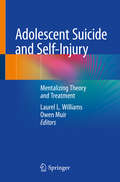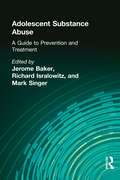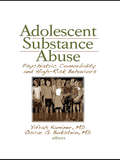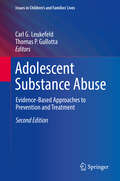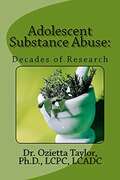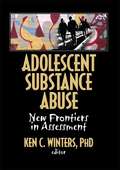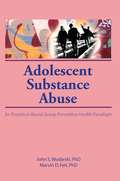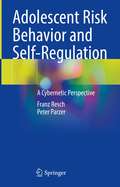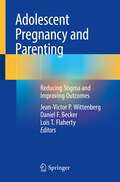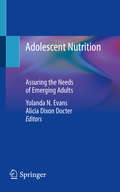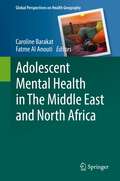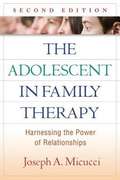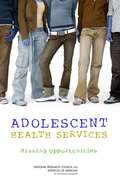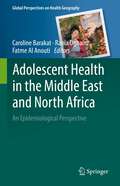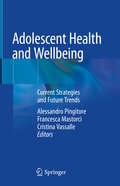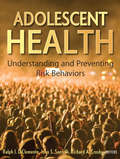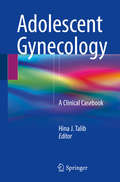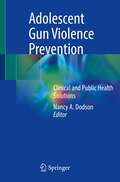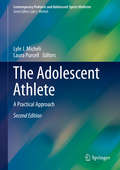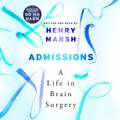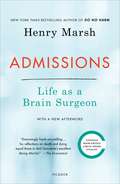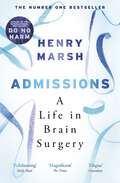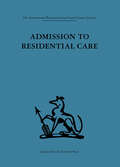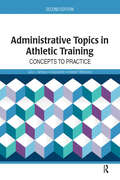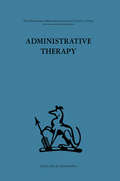- Table View
- List View
Adolescent Suicide and Self-Injury: Mentalizing Theory and Treatment
by Laurel L. Williams Owen MuirThis volume presents a comprehensive and practical approach to the treatment of suicide and NSSI for adolescents utilizing a mentalizing framework. The beginning of the text provides up-to-date information on the theory of a mentalizing therapy in order to ground the readers in the neuroscientific underpinnings of a mentalizing approach. Next chapters provide information on the fundamental building blocks of a mentalizing therapy at the individual and family level. These chapters provide step-by-step approaches in order to provide examples of the techniques involved in mentalizing treatment that can be employed to address suicidality and NSSI. The next chapter builds on these concepts as the reader learns about mentalizing failures involved in common co-morbidities in adolescents who are experiencing suicidality and/or employing NSSI. The next several chapters cover practical issues related to working within this patient population including the key concept of social systems and connections for both providers and adolescents, the ability of mentalizing theory and therapy to integrate with other effective therapies, how to approach sessions after a suicide attempt, resiliency for patient, family and the provider, along with important self-care for a therapist if a patient commits suicide. The final chapter brings all of the aforementioned elements together in order for the reader to conceptualize employing a mentalizing approach to adolescents and their families when suicide and NSSI concerns are a predominate focus of care. Illustrations of specific therapeutic approaches and a list of resources and guidelines where available are also included.Adolescent Suicide and Self-Injury is an excellent resource for all clinicians working with youths at risk for suicide and/or self-injury, including psychiatrists, psychologists, pediatricians, family medicine physicians, emergency medicine specialists, social workers, and all others.
Adolescent Substance Abuse: A Guide to Prevention and Treatment
by Jerome Beker Richard Isralowitz Mark SingerAn enlightening discussion of the major issues related to the prevention and treatment of adolescent substance abuse. Information-packed chapters lend a new perspective to the field and suggest implications for practice in services for youth.
Adolescent Substance Abuse: Psychiatric Comorbidity and High Risk Behaviors
by Yifrah KaminerLearn more effective treatments for adolescents with abuse substance disorder Dual diagnosis of adolescent substance use disorders and comorbid psychiatric disorders must be treated simultaneously to be effective. Adolescent Substance Abuse: Psychiatric Comorbidity and High Risk Behaviors presents leading experts offering insightful viewpoints and dynamic suggestions on how to best provide simultaneous treatment and integrated services to these youths. The book covers the state of the art in the field of substance use disorders, and reviews different psychiatric disorders and high risk behaviors, and then addresses the issue of integrated services and ethical, legal, and policy issues pertaining to this population. In the field of adolescent substance abuse treatment, dual diagnosis is the rule rather than the exception, making assessment and treatment complicated. Adolescent Substance Abuse: Psychiatric Comorbidity and High Risk Behaviors comprehensively discusses the magnitude, etiology, and characteristics of problems and substance abuse disorders (SUD), and extensively explains ways to assess, treat, and develop services for adolescents. This unique text closely examines the assessment and treatment of psychiatric comorbid disorders among adolescents such as depression, anxiety disorders, ADHD, and high risk behaviors including suicidal behavior, self-harm behavior, and gambling behavior. The text is extensively referenced and several chapters include helpful tables and figures to clearly display the data. Topics examined in Adolescent Substance Abuse: Psychiatric Comorbidity and High Risk Behaviors include: etiology of adolescent substance abuse assessment treatment planning psychosocial interventions pharmacological interventions disruptive behavior disorders attention deficit hyperactivity disorder depression bi-polar mood disorder anxiety disorders trauma and post traumatic stress disorder (PTSD) suicidal and self-harm behaviors schizophrenia eating disorder gambling behavior Adolescent Substance Abuse: Psychiatric Comorbidity and High Risk Behaviors is an invaluable resource for mental health professionals, pediatricians, family physicians, nurses, addictions specialists, counselors, educators, students, and drug court professionals who provide assessment and treatment for youths with substance use disorders.
Adolescent Substance Abuse: Evidence-Based Approaches to Prevention and Treatment (Issues in Children's and Families' Lives #9)
by Carl G. Leukefeld Thomas P. GullottaThe second edition of this book incorporates the latest theory, research, and best practices for understanding, treating, and preventing substance abuse among adolescents. It updates the progress made in treatments for and prevention of the misuse of substances and adds new specific chapters on prescriptions, opiates, and methamphetamine abuse. The book discusses the effects of commonly abused substances, from tobacco and alcohol to stimulants and opioids, on the human brain and the various psychosocial routes to their misuse by adolescents. Chapters provide evidence-based guidelines for assessing adolescent treatment needs and review psychological, pharmacological, family, and self-help interventions. The book offers new paths in diverse directions, analyzes the core components of substance use prevention, critiques emerging school-based interventions, and introduces a nuanced reconceptualization of recovery.Topics featured in the book include:The effect of family and caregiver situations on adolescent substance abuse.A biological/genetic perspective on adolescent substance abuse.School-based preventions and the evolution of evidence-based strategies.The role of adolescent self-help in substance abuse interventions.Community-based interventions to reduce alcohol use and misuse. Adolescent Substance Abuse, Second Edition, is a must-have reference for researchers, clinicians/practitioners, and graduate students in the fields of child and school psychology, social work, public health, developmental psychology, child and adolescent psychiatry, and various interrelated mental health and social policy arenas.
Adolescent Substance Abuse: Decades Of Research
by Ozietta TaylorMany contemporary adolescents believe that medication received from a physician office or hospital is not addicting; yet, many are becoming addicted to substances that are found in their home medicine cabinets. Research indicates that some adolescents are at risk of developing a substance use disorder. Therefore, this book alerts the reader to the hazards of adolescent substance abuse-its trends and treatment
Adolescent Substance Abuse: New Frontiers in Assessment
by Ken Winters CStay up-to-date in the continuing fight to assess and treat adolescent drug and alcohol abuse Adolescent Substance Abuse: New Frontiers in Assessment presents up-to-date research on the assessment, intervention, and treatment of alcohol and drug use behaviors in adolescents, using screening tools developed to accurately measure the extent and nature of the problem. This unique book provides evidence of how the field has matured over the past 20 years, highlighting the rapid growth in research with a focus on topics deserving of more study. Leading experts working in adolescent health and assessment examine treatment-oriented typologies, treatment matching, problem identification and referral, parent-report, self-report, and the compatibility of anonymous and confidential surveys. Recent advancements in the development and evaluation of research materials have led to vast improvements in the study of adolescent drug abuse. Counselors can now depend on user-friendly features and rigorous psychometric evidence in determining the important differences between adolescent and adult drug use; distinguishing between normative and severe-end drug use behaviors; detecting "faking bad," "faking good," and other sources of compromised self-reports; and developing a greater understanding of substance abuse disorders. Still, challenges remain-the validity of adolescent self-report tools is vital; there is a need for more precise identification of related psychosocial problems, and there is a lack of data of whether current assessment tools can identify distinct levels of a problem&’s severity. Adolescent Substance Abuse works to meet those challenges. Adolescent Substance Abuse examines: how assessment can be used to identify treatment-oriented typologies to improve treatment matching how to use community readiness for drug abuse prevention how to use the psychometric data of a screening tool for problem identification urinalysis, parent report and self-report in working with American Indian youth parent-child concordance in assessment of substance use anonymous versus confidential survey formats in Mexico, Puerto Rico, and the United States gender differences in measuring substance abuse and much more Adolescent Substance Abuse is an essential professional resource for counselors and researchers working in the field of adolescent health, particularly drug abuse.
Adolescent Substance Abuse: An Empirical-Based Group Preventive Health Paradigm
by John S Wodarski Marvin D FeitHere is a comprehensive review of adolescent substance abuse issues and an expansive, empirically based curriculum for school-based programs to teach adolescents about the dangers of drugs and alcohol. The abuse of alcohol and other drugs among young people is a problem of alarming scope and gravity. Adolescent Substance Abuse explores the multiple forces which impact adolescents and can push them toward drug and alcohol abuse.Adolescent Substance Abuse proposes means by which to effect macro-level change in societal norms and values regarding substance abuse. The authors describes in detail an effective means of teaching adolescents about drugs and alcohol using an empirically based teaching method called Teams-Games-Tournaments (TGT). TGT was developed through extensive research on games used as teaching devices. It uses small groups as classroom work units and capitalizes on peer influence by using peers as teachers and supporters. The book explains an effective curriculum which utilizes the TGT approach and provides a program for parents. The curriculum is unique in that it is anchored in empirical data and delivered via adolescent peer groups. Adolescent Substance Abuse addresses other issues pertinent to the reduction of adolescent substance abuse by exploring subsystems of change, including school and peer group environments, home and family, the media, community movements, and business and industry. The book is a great source of innovative ideas for beginning and expert counselors, social workers, mental health professionals, school psychologists, and others who want to prevent adolescent abuse of drugs and alcohol.
Adolescent Risk Behavior and Self-Regulation: A Cybernetic Perspective
by Franz Resch Peter ParzerThis book is based on the idea that increasing juvenile risk behaviours – like substance abuse, nonsuicidal self-injury, and antisocial or suicidal behaviour – allow adolescents to fulfill developmental tasks like identity-formation and regulation of self-worth. Narcissistic self-exploitation, mobility tasks, flexibility and the challenges of new media exert social pressure on parental figures, distracting and putting strain on their mental resources, which in turn changes and even destroys the emotional dialogue with their offspring. If children themselves experience neglect and lack of emotional bonding - resulting in a lack of self-regulating capacities – risk behaviours are the consequence. The book combines different views in the psychological, social and metatheoretical domains. It consists of three parts: developmental problems of young people, diagnosis of risk behaviours in the nosological framework, and presentation of new morbidity with an increase in symptom prevalence. The book also discusses the threat of the acceleration of social processes and the risks of postmodern society.
Adolescent Pregnancy and Parenting: Reducing Stigma and Improving Outcomes
by Jean-Victor P. Wittenberg Daniel F. Becker Lois T. FlahertyThis book focuses on the impact of social stigma on adolescents who are at high risk of teen pregnancy. It describes and discusses personal and social factors that predispose them to becoming pregnant and having babies; factors that may subsequently protect or more often, compromise outcomes for both parents and children. The authors, who represent a range of social roles and perspectives, describe the pathways from stigma and its unfounded beliefs about disadvantaged adolescents, to the ways stress burdens teen parents and their children. They note that successful teen parents often go unrecognized and wonder how many more are hobbled by stigma. They recognize the lifespan impacts of stress as described in the ACE studies; stress that has psychological, health and economic implications at individual and social levels. They examine the impact of stigma on parent-child relationships and the attachment system, a stress management system, learned in infancy and persisting into adulthood. The book describes how stigma finds its way into daily interpersonal encounters, systemic policies and practices, and even into healthcare research and services.This sets the stage for an in-depth look at attachment systems within stress management, interventions, and recommendations for professionals whose work is impacted by these issues. Written by experts in the field, this text is the first to cover the current understanding of the risk factors, advanced understanding of developmental issues, and the key intervention tactics for the most positive outcome for adolescent parents and their families.Adolescent Pregnancy and Parenting is an excellent resource for psychiatrists, psychologists, physicians, social workers, educators, researchers, and policy makers working with youths at risk for teenage pregnancies.
Adolescent Nutrition: Assuring the Needs of Emerging Adults
by Yolanda N. Evans Alicia Dixon DocterAdolescents have unique nutritional needs when compared to young children and adults. As youth go through physical, cognitive, and behavioral development, nutrition needs are dynamic and changing. If these needs go undetected and remain unaddressed, the results can derail physical and social maturation and include life-long effects on health. This comprehensive text offers a multidisciplinary perspective on aspects of adolescent nutrition. Using clinical cases, it covers relevant topics related to adolescent health including normal development, chronic health conditions, and complex biopsychosocial dynamics, among others. The first section of the text contains an overview of adolescent nutrition that is further broken down into more specific topics such as developmental nutrition needs, needs of active youth and athletes and media influences on body image. The next section focuses on health disparities such as culturally appropriate care, health equity, international considerations and food insecurity. The following section specifically addresses eating disorders ranging from anorexia and bulimia to binge eating. Finally, the last section covers additional health considerations such as polycystic ovarian syndrome, teen pregnancy, substance use and gender non-conforming youth. Written by experts in the field, this book is a helpful resource for primary care medical providers, registered dietitians/nutritionists (RDN), adolescent medicine specialists, as well as advanced practice nurses, physician assistants, psychologists, licensed social workers, and certified athletic trainers.
Adolescent Mental Health in The Middle East and North Africa (Global Perspectives on Health Geography)
by Caroline Barakat Fatme Al AnoutiThis 2-volume set focuses on adolescent health in the Middle East and North Africa region (MENA), and presents the latest research on the health risk behaviours and social behaviours that adolescents from the MENA region engage in. While there has been a surge in peer-reviewed research publications on population health in the MENA region in the last couple of decades, very few books offer a resource to address the diverse negative influences that disproportionately affect adolescents and children in the MENA region, including increased tobacco consumption culture, low emphasis on physical activity, increased sedentary behaviours, weak health policies, and societal issues related to displacement and political conflicts. These books offer a synthesis of current knowledge on adolescent health issues in the MENA region, and aim to provide evidence-informed adolescent health care practices that address current issues related to mental, physical, reproductive and nutritional health. Volume 1 focuses on mental health in the MENA region, the development and implementation of youth friendly public policies, and how to strategize in the age of COVID-19. The study will aid health care professionals, policy makers, government organizations and health program planners to assess current policies and practices related to adolescent health in the MENA region, and to identify the best courses of action moving forward.
Adolescent in Family Therapy, Second Edition
by Joseph Micucci Celia FalicovRich with clinical wisdom, this successful text and practitioner guide offers a comprehensive framework for treating adolescent problems in the family context. Even as teenagers become increasingly independent, Joseph Micucci shows, they still need parental guidance and nurturance. By strengthening family relationships, clinicians can alleviate symptoms and promote behavioral change. Vivid examples and session transcripts illustrate specific strategies for treating eating disorders, depression, anxiety, defiance, underachievement, and other frequently encountered challenges. Weaving together family therapy techniques with ideas from psychodynamic and cognitive-behavioral approaches, the book has a pragmatic focus on effective interventions for getting adolescent development back on track. New to This Edition Thoroughly updated to reflect current research and reader feedback. Chapter on adolescent anxiety disorders. Expanded coverage of attachment issues; lesbian, gay, and bisexual youth; and racial and ethnic identity. New case material, one of the book's most popular features.
Adolescent Health Services: Missing Opportunities
by National Research Council Institute of Medicine of the National AcademiesAdolescence is a time of major transition, however, health care services in the United States today are not designed to help young people develop healthy routines, behaviors, and relationships that they can carry into their adult lives. While most adolescents at this stage of life are thriving, many of them have difficulty gaining access to necessary services; other engage in risky behaviors that can jeopardize their health during these formative years and also contribute to poor health outcomes in adulthood. Missed opportunities for disease prevention and health promotion are two major problematic features of our nation's health services system for adolescents. Recognizing that health care providers play an important role in fostering healthy behaviors among adolescents, Adolescent Health Services examines the health status of adolescents and reviews the separate and uncoordinated programs and services delivered in multiple public and private health care settings. The book provides guidance to administrators in public and private health care agencies, health care workers, guidance counselors, parents, school administrators, and policy makers on investing in, strengthening, and improving an integrated health system for adolescents.
Adolescent Health in the Middle East and North Africa: An Epidemiological Perspective (Global Perspectives on Health Geography)
by Caroline Barakat Rania Dghaim Fatme Al AnoutiThis 2-volumeset focuses on adolescent health in the Middle East and North Africa region (MENA), and presents the latest research on the health risk behaviours and social behaviours that adolescents from the MENA region engage in. While there has been a surge in peer-reviewed research publications on population health in the MENA region in the last couple of decades, very few books offer a resource to address the diverse negative influences that disproportionately affect adolescents and children in the MENA region, including increased tobacco consumption culture, low emphasis on physical activity, increased sedentary behaviours, weak health policies, and societal issues related to displacement and political conflicts. These books offer a synthesis of current knowledge on adolescent health issues in the MENA region, and aim to provide evidence-informed adolescent health care practices that address current issues related to mental, physical, reproductive and nutritional health. Volume 2 focuses on nutritional and reproductive health in the MENA region, predictive modelling of obesity, determinants of sexual and oral health, HIV, and diabetes. The study will aid health care professionals, policy makers, government organizations and health program planners to assess current policies and practices related to adolescent health in the MENA region, and to identify the best courses of action moving forward.
Adolescent Health and Wellbeing: Current Strategies and Future Trends
by Alessandro Pingitore Francesca Mastorci Cristina VassalleThis book presents a detailed and updated review of the widespread changes that take place during adolescence, adopting a preventive perspective that reflects physical, social, cognitive, and emotional changes. It addresses a broad range of aspects, including: the preventive programs and their systemic effects; the role of environment in influencing the healthy behaviors of adolescents and young adults; the use of e-Health technology in health and behavioral interventions for adolescents; and the clinical and prognostic implications of primordial prevention in healthy adolescents. All of these elements are subsequently reviewed using a multidimensional approach, in order to offer extensive information on the complex changes that characterize adolescents’ physiological, psychological, and neurobiological development.In addition, the book depicts the preventive strategies currently used in various social settings (school, family, sport club, health policies) aimed not only at reducing lifestyle risk behaviors, but also at improving resilience, happiness, social involvement, self-esteem, and sociability. This update is essential in the light of the fact that, to date, prevention has mainly been directed towards adolescents with physical or mental disorders rather than their healthy peers. As such, the book offers a valuable tool for pediatricians, child and adolescents psychiatrists, and for all professionals involved in Health Promotion and Disease Prevention.
Adolescent Health
by Richard A. Crosby John S. Santelli Ralph J. DiclementeThis book covers the developmental and health problems unique to the adolescent period of life. It focuses on special needs and public health programs for adolescents. It offers deep insight into smoking, violence, teen pregnancy, HIV/AIDS, and other problems, along with intervention and prevention strategies."Anyone serious about improving adolescent health should read this book. It spans theoretical and developmental constructs, summaries of evidence-based interventions for adolescent risk behaviors, metrics, and policy recommendations." --S. Jean Emans, MD, chief, Division of Adolescent Medicine, and Robert Masland Jr., chair, Adolescent Medicine, Children's Hospital Boston, and professor of pediatrics, Harvard Medical School"This is the one single text that students can use to study adolescent health. It includes contributions from many of the world's most accomplished researchers to provide learners with cutting edge information to make the study of adolescence understandable and applicable in practical settings." --Gary L. Hopkins, MD, DrPH, associate research professor and director, Center for Prevention Research, and director, Center for Media Impact Research, Andrews University"This textbook presents an excellent balance in weighing the evidence from the risk and the resilience literature, incorporating research in racially and ethnically diverse populations." --Renée R. Jenkins, MD, FAAP, professor, Department of Pediatrics and Child Health, Howard University College of Medicine"This is an engaging, thorough, and thought-provoking statement of our knowledge about adolescence. " --Wendy Baldwin, PhD, director, Poverty, Gender, and Youth Program, Population Council
Adolescent Gynecology: A Clinical Casebook
by Hina J. TalibThis book offers a comprehensive and clinically relevant survey of adolescent gynecology. Adolescent Gynecology: A Clinical Casebook addresses the many intersecting considerations of gynecologic and reproductive health care for this population using a concise, case-based format. Organized in four sections, the first introduces chapters on adolescent confidentiality, puberty, and well care. Section II covers varied menstrual disorders, while Section III highlights issues in reproductive health care including sexually transmitted infection and adolescent pregnancy. Finally, Section IV addresses special populations of adolescents, including chapters on girls who have sex with girls, girls who are victims of abuse and girls with special health care needs and chronic health conditions. In each section common gynecologic health issues are discussed in the context of these clinical cases, provide the knowledge needed to further improve comprehensive care of adolescent patients. Adolescent Gynecology: A Clinical Casebook is a unique resource that delivers essential clinical information for Adolescent Medicine and Pediatric and Adolescent Gynecology fellowship trainees, as well as for medical students, resident trainees, and primary care practitioners who are the front-line caregivers for adolescent girls.
Adolescent Gun Violence Prevention: Clinical and Public Health Solutions
by Nancy A. DodsonEach year, gun violence kills approximately 2,700 and injures approximately 14,500 children in the U.S.; the overwhelming majority of child gun deaths are among teenagers who die by homicide or suicide. Gun violence is the leading cause of death for Black teens. A recent spate of high-profile tragedies involving children, such as the Newtown mass shooting in 2012 and the Parkland mass shooting in 2018, have reinvigorated a national debate about the role of guns in our private and public spaces. Physicians, and in particular pediatricians, have become increasingly vocal about the need to address the epidemic of gun violence in the U.S.This book serves as an in-depth, comprehensive guide to adolescent gun violence prevention. It describes the epidemiology of teen gun violence in the U.S. by focusing on the parallel epidemics that claim the most lives: gun suicide among rural white males, and gun homicide among urban Black males. It offers in-depth reviews of key concepts that are crucial to reaching a meaningful understanding of gun violence. The text also addresses specific methods of intervention at various levels of society, from the individual; to the local community; and finally to the entire nation. This first of its kind book is a valuable reference for physicians, public health scientists, policy-makers, gun reform advocates, and anyone interested in working towards a safer future for young people.
The Adolescent Athlete: A Practical Approach (Contemporary Pediatric and Adolescent Sports Medicine)
by Laura Purcell Lyle J. MicheliThis reader-friendly book takes a practical approach to caring for the adolescent athlete. Logically organized by joint, the book identifies both chronic and acute injuries in addition to congenital conditions. It details fundamentals, including basic anatomy, joint examination, and patient history. Emphasis is placed on the recognition of injury patterns unique to adolescent athletes and tables are incorporated throughout to assist with diagnosis. This book also highlights return to play guidelines and includes summary pearls. Anatomical photos, x-rays, and MRI scans illustrate all key concepts.
Admissions: A Life in Brain Surgery
by Henry Marsh'Sensational' SUNDAY TIMES NO. BESTSELLER'Extraordinary...both exhilarating and alarming...fascinating' DAILY MAIL'Wonderful...a testament to the tenacity of the human spirit' FINANCIAL TIMESHenry Marsh has spent four decades operating on the human brain. In this searing and provocative memoir following his retirement from the NHS, he reflects on the experiences that have shaped his career and life, gaining a deeper understanding of what matters to us all in the end.Written and read by Dr Henry Marsh(p) 2017 Orion Publishing Group
Admissions: Life as a Brain Surgeon
by Henry MarshThe International Bestseller"Consistently entertaining...Honesty is abundantly apparent here--a quality as rare and commendable in elite surgeons as one suspects it is in memoirists." —The Guardian"Disarmingly frank storytelling...his reflections on death and dying equal those in Atul Gawande's excellent Being Mortal." —The EconomistHenry Marsh has spent a lifetime operating on the surgical frontline. There have been exhilarating highs and devastating lows, but his love for the practice of neurosurgery has never wavered. Following the publication of his celebrated New York Times bestseller Do No Harm, Marsh retired from his full-time job in England to work pro bono in Ukraine and Nepal. In Admissions he describes the difficulties of working in these troubled, impoverished countries and the further insights it has given him into the practice of medicine. Marsh also faces up to the burden of responsibility that can come with trying to reduce human suffering. Unearthing memories of his early days as a medical student, and the experiences that shaped him as a young surgeon, he explores the difficulties of a profession that deals in probabilities rather than certainties, and where the overwhelming urge to prolong life can come at a tragic cost for patients and those who love them.Reflecting on what forty years of handling the human brain has taught him, Marsh finds a different purpose in life as he approaches the end of his professional career and a fresh understanding of what matters to us all in the end.
Admissions: A Life in Brain Surgery
by Henry Marsh'Sensational' SUNDAY TIMES NO. BESTSELLER'Extraordinary...both exhilarating and alarming...fascinating' DAILY MAIL'Wonderful...a testament to the tenacity of the human spirit' FINANCIAL TIMESHenry Marsh has spent four decades operating on the human brain. In this searing and provocative memoir following his retirement from the NHS, he reflects on the experiences that have shaped his career and life, gaining a deeper understanding of what matters to us all in the end.
Admission to Residential Care
by Glenys Jones Gwyneth Roberts Paul Brearley Frank Hall Penny GutridgeTavistock Press was established as a co-operative venture between the Tavistock Institute and Routledge & Kegan Paul (RKP) in the 1950s to produce a series of major contributions across the social sciences. This volume is part of a 2001 reissue of a selection of those important works which have since gone out of print, or are difficult to locate. Published by Routledge, 112 volumes in total are being brought together under the name The International Behavioural and Social Sciences Library: Classics from the Tavistock Press. Reproduced here in facsimile, this volume was originally published in 1980 and is available individually. The collection is also available in a number of themed mini-sets of between 5 and 13 volumes, or as a complete collection.
Administrative Topics in Athletic Training: Concepts to Practice
by Andrew P. Winterstein Gary Harrelson Greg GardnerAdministrative Topics in Athletic Training: Concepts to Practice, Second Edition continues to be a dynamic text that addresses important administrative issues, practices, and procedures, as well as fundamental concepts, strategies, and techniques related to the management of all aspects of an athletic training health care delivery system. Uniquely, this text balances theory and application around management, administration, and leadership for the athletic trainer in multiple practice settings.Inside the Second Edition, Drs. Gary Harrelson, Greg Gardner, and Andrew Winterstein feature case studies and instructional activities, both within the text and instructor materials, to help athletic training students and clinicians understand and apply the concepts to “real world” scenarios. Numerous graphic elements such as boxes, callouts, tables, and illustrations are included throughout the text to enhance readability.New and updated features to the Second Edition: Numerous case studies, examples, and classroom activities 12 appendices provide tools and examples to aid in the application of concepts and principles addressed in the text Each chapter uses an Advanced Organizer to aid the reader in chapter orientation All chapters have been updated to include changes in laws, regulations and practices Issues in educational and clinical settings are broken into different chapters Chapters have been grouped into three sections to improve flow of the text— Personal Practices, Athletic Training Practices and Organizational Practices Faculty will have access to an Instructor’s Manual, PowerPoint slides, and Test Bank Questions Updated topics inside the Second Edition: Use of social media Multiple generations in the workplace Time management and prioritization Process of writing a business plan Athletic training as a business Starting your own business Administrative models in educational settings Impact of degree transition in athletic training Guidelines for appropriate medical coverage in secondary school and university settings Expanding roles of Athletic Trainers in clinical settings Included with the text are online supplemental materials for faculty use in the classroom.Administrative Topics in Athletic Training: Concepts to Practice, Second Edition provides beneficial information on administrative topics and will be a useful resource for athletic training students, practitioners, and any administrator responsible for supervision of athletic trainers and athletic training service programs.
Administrative Therapy: The role of the doctor in the therapeutic community
by David H ClarkTavistock Press was established as a co-operative venture between the Tavistock Institute and Routledge & Kegan Paul (RKP) in the 1950s to produce a series of major contributions across the social sciences. This volume is part of a 2001 reissue of a selection of those important works which have since gone out of print, or are difficult to locate. Published by Routledge, 112 volumes in total are being brought together under the name The International Behavioural and Social Sciences Library: Classics from the Tavistock Press. Reproduced here in facsimile, this volume was originally published in 1964 and is available individually. The collection is also available in a number of themed mini-sets of between 5 and 13 volumes, or as a complete collection.
